2024 Wired, WLAN Gartner Magic Quadrant: Soon-To-Be-Joined Juniper Networks, HPE Best Cisco
The 2024 Gartner Magic Quadrant for Enterprise Wired and Wireless LAN Infrastructure features a busy Leaders quadrant commanded by Juniper Networks and HPE Aruba, which are slated to come together by the end of 2024 or early 2025.
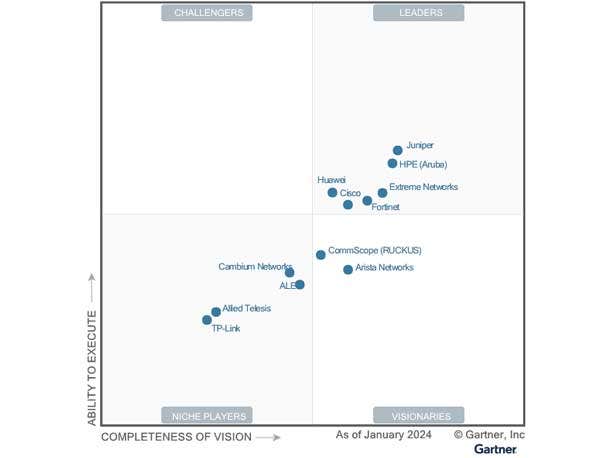
The 2024 Gartner Magic Quadrant for Enterprise Wired and Wireless LAN Infrastructure report is out, and the headline this year is that Juniper Networks and HPE Aruba Networking nabbed the top two spots in the Leaders quadrant at a time when competition is fierce in the networking space.
Juniper Networks grabbed the No. 1 position with HPE Aruba Networking in second place. The report comes just months after HPE revealed plans to acquire Juniper in a $14 billion deal that sets up a battle for network supremacy in the AI era and poses a potential threat to networking market heavyweight Cisco Systems.
However, Cisco once again was listed in the Leaders quadrant, which was also occupied by Huawei, Extreme Networks and Fortinet, all of which are report mainstays over the last few years. The 2024 report featured an empty Challengers quadrant; four Niche Players, including one newcomer, Allied Telesis; and two Visionaries.
With 12 wired and wireless vendors landing on the 2024 Magic Quadrant this year, here are the companies that ranked as Leaders, Niche Players or Visionaries, as well as the strengths and weaknesses of each vendor, according to Gartner.
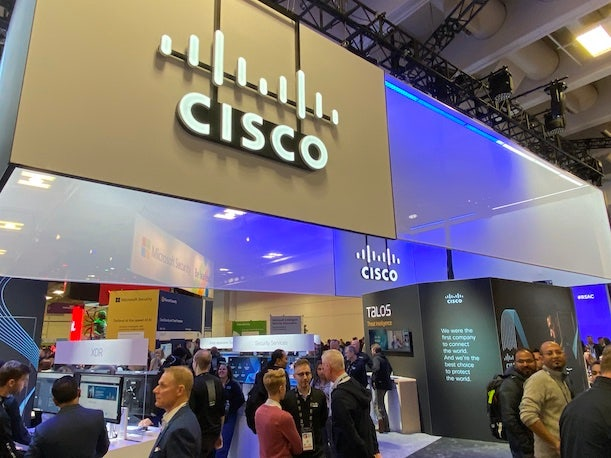
Leader: Cisco Systems
Cisco is one of the Leaders in this year's Magic Quadrant once again, thanks to its Catalyst and Meraki portfolios of wired and wireless access products, network applications and services. Cisco’s Networking Cloud, the company’s platform approach to networking, works to bring together its on-premises Catalyst hardware with the simplicity of its popular cloud-based Meraki management model. Gartner said that the networking giant has been working toward use-case parity and experience consistency across the two portfolios.
Strengths: Gartner pointed to the scope of Cisco’s wired and wireless hardware and software product portfolio and the company’s integration of ThousandEyes throughout the portfolio as strong points for the company. Cisco’s global reach within direct and indirect sales channels are also feathers in the company's cap.
Weaknesses: Rising prices for buying, refresh and maintaining Cisco’s wired and wireless infrastructure, as well as the disconnect between on-premises and cloud parity that’s still forcing customers to make a decision on the management solution they intend to deploy—Meraki in the cloud, or Catalyst Center on-premises—are cautions that Gartner pointed out about Cisco.
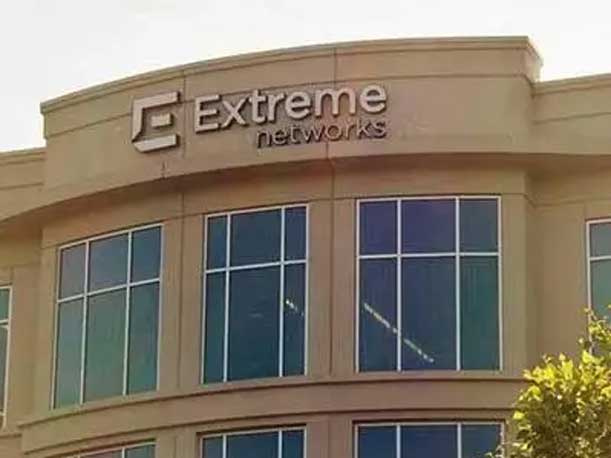
Leader: Extreme Networks
A Leader for the sixth time, networking specialist Extreme Networks’ portfolio ties together wired, wireless and SD-WAN products into a single offering that’s layered on top of Extreme Fabric, a zero touch, automated network fabric that employs a unified management platform that’s available in the cloud or on-premises. The company is also investing in its ExtremeCloud IQ CoPilot AI capabilities, universal ZTNA and digital twin initiatives.
Strengths: Extreme Networks has been consistently investing in its single, secure end-to-end fabric technology that offers zero touch provisioning and automation for IT teams. The company’s universal licensing also gives customers a flexible licensing approach with licenses that are not tied to specific hardware, Garner said.
Weaknesses: Extreme Networks has gaps in certain markets, including in Asia and Latin America, according to Gartner. The vendor also doesn’t directly offer a consumption-based NaaS offering, Gartner said.
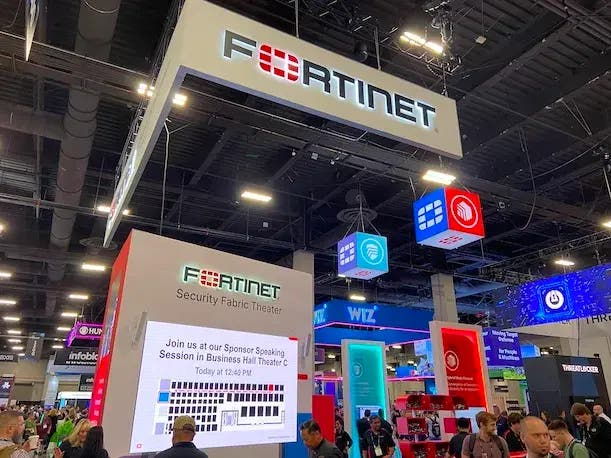
Leader: Fortinet
Fortinet, a security and networking player, is a Leader in this year’s Magic Quadrant. Fortinet Security Fabric offers extremely tight integration between its wired and wireless products, Gartner said. The company is expected to continue to invest in its network AIOps capabilities and improve its threat detection capabilities.
Strengths: Fortinet’s strong suit is that the company, unlike some of its rivals, offers wired, wireless and security integrated under a single unified operating system, FortiOS, and cloud management platform. Gartner also pointed to the company's FortiAIOps AI engine as important in offering network assurance across security, wired and wireless.
Weaknesses: Gartner said that most of Fortinet’s security customer base is still buying switches and WLAN products from a networking competitor. Fortinet also has several management options, including FortiGate manager, FortiManager, FortiLAN and FortiMonitor, which can result in a confusing mix of management options.
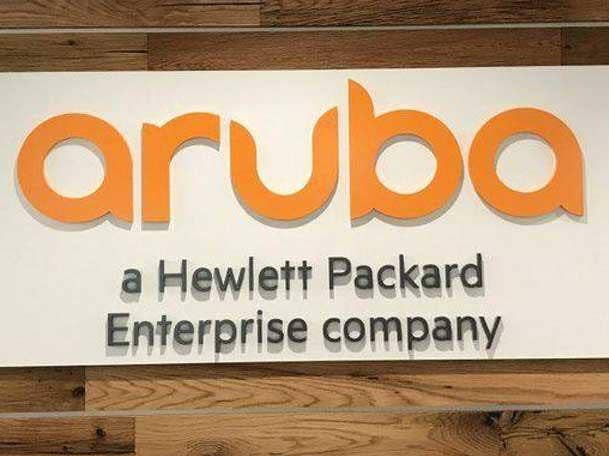
Leader: HPE Aruba Networking
HPE Aruba Networking is a Leader once again thanks to what Gartner calls its comprehensive approach to enterprise networking through the Aruba Edge Services Platform (ESP) of wired and wireless offerings. Aruba has been aggressively expanding its NaaS offering through its channel, including new offerings that include the broader HPE GreenLake ecosystem, Gartner said.
Strengths: Gartner cites Aruba ESP, which offers an automated and secure wired and wireless fabric, as a main strength for the company, in addition to its inclusive AI features and switching advancements.
Weaknesses: HPE Aruba has multiple NaaS offerings for end customers and its channel, which have been cited as confusing for prospective buyers consider licensing options. Gartner also said Aruba has focused investment on its Central cloud and on-premises management and lacks third-party network management.
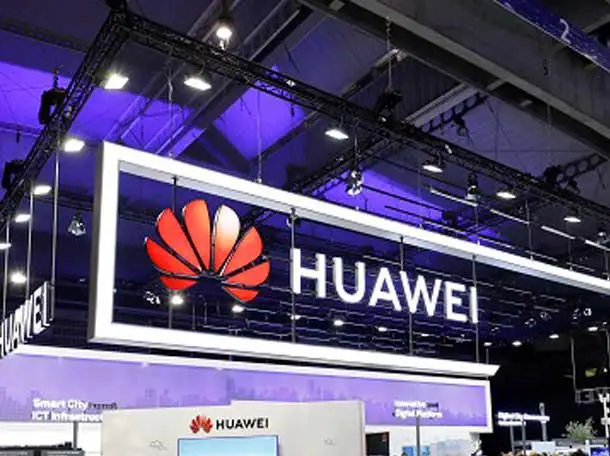
Leader: Huawei
Huawei was cited as a Leader in this year’s Magic Quadrant due to its CloudCampus offering, which provides CloudEngine S-series switches, AirEngine wireless APs and iMaster NCE applications that can be broadly used to address a wide range of use cases. Gartner expects the company to continue to invest in its Wi-Fi 7 portfolio and antenna technology.
Strengths: Huawei offers a full wired and wireless product portfolio. Its converged campus network architecture integrates OT capabilities into traditional enterprise products and can simplify the migration of OT to IT, Gartner said.
Weaknesses: Huawei continues to face ongoing geopolitical issues that limit its exposure in some geographies and vertical markets, including in North America, the U.K. and Australia. The company also does not have a NaaS offering, Gartner said.
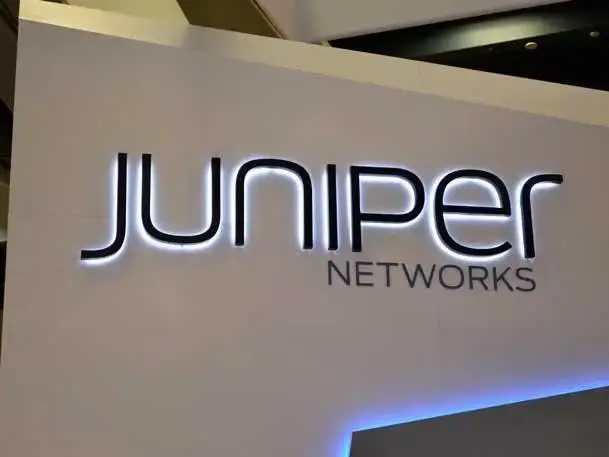
Leader: Juniper Networks
Juniper Networks comes to market with its wired and wireless LAN offerings, which include its EX series switches, QFX series switches and wireless access points driven by the company’s Mist AI engine. The company is heavily investing in its integrated AI and machine learning operations, as well as cloud-based security capabilities, Gartner said.
Strengths: Juniper is a market leader when it comes to AI/ML-driven capabilities, and its products have demonstrated the ability to automatically fix routine issues and simplify network operations. The company also offers a strong security framework and simplified network management, Gartner said.
Weaknesses: Juniper's campus fabric lacks third-party support and there is limited customer traction of the company’s NaaS offering, according to Gartner.

Niche Player: Alcatel-Lucent Enterprise (ALE)
ALE, a Niche Player, brings to market its OmniSwitch switches, OmniAccess Stellar wireless access points and OmniVista management products. The company’s portfolio includes on-premises and cloud-based management options with network fabric segmentation and universal network policy for IT and IoT provisioning, according to Gartner.
Strengths: ALE’s key target verticals, which include government, health care, transportation and education, can benefit from ALE’s campus networking fabric architecture and industry-specific expertise. The company also has strong partnerships in SASE, SSE cloud security solutions and video management systems, Gartner said.
Weaknesses: Gartner said ALE is trailing many of the leaders this year when it comes to advanced visibility and assurance functions. In addition, while ALE offers a buying model for customers that includes some Capex in the initial purchase, it does not meet Gartner’s definition for NaaS.
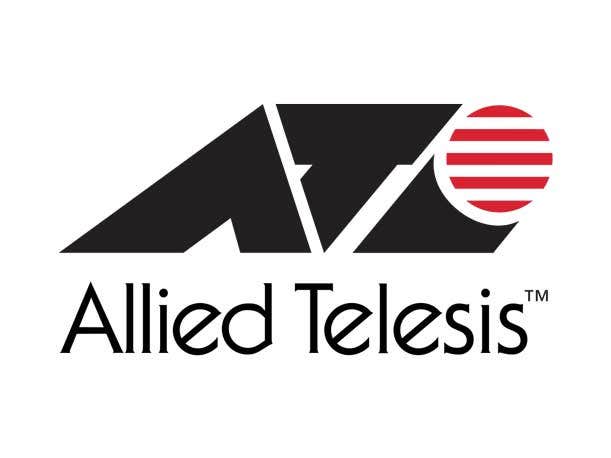
Niche Player: Allied Telesis
Allied Telesis, the only newcomer to this year’s Magic Quadrant, joins as a Niche Player. The company offers a broad switching portfolio anchored by its x9x0 series switches and a WLAN offering that can address most use cases but is currently missing a Wi-Fi 6E model.
Strengths: Allied Telesis offers enterprise-grade network management features in the form of AMF Plus and its AMF Security Controller, which are optional add-ons to Vista Manager EX. The company has a single OS, AlliedWare Plus, which makes management and configuration simple across all its products, including routers and firewalls, Gartner said.
Weaknesses: Allied Telesis does not yet have AI/ML-based analytics for network assurance services. The company also has limited wired and wireless LAN market visibility among customers and prospects outside Japan, Gartner said.
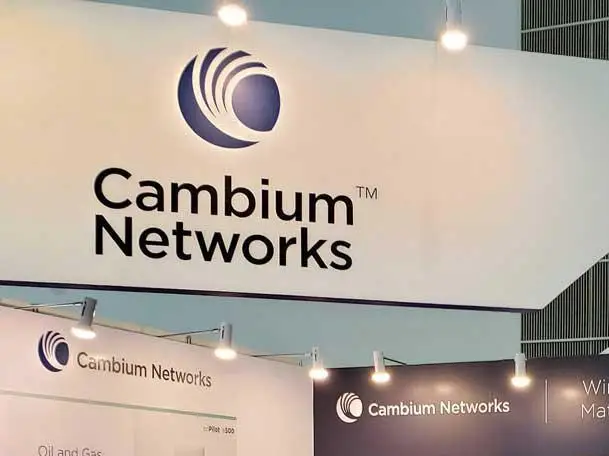
Niche Player: Cambium Networks
Niche Player Cambium Networks offers its ONE Network product that addresses the enterprise with wired switches via the company’s cnMatrix product line and access points with software-defined radios. Cambium is focused on customers in the hospitality, education, government and health-care sectors.
Strengths: Cambium’s recently introduced Network Service Edge (NSE) offering extends cnMaestro’s network management to include SD-WAN, network security and outdoor fixed wireless, Gartner said. The company’s access points also feature flexible software-defined radios.
Weaknesses: Cambium doesn’t offer a modular chassis switch, a portfolio gap that prevents it from adequately addressing high-density access or high-speed core/distribution use cases, Gartner said. The company also has limited enterprise vertical exposure.
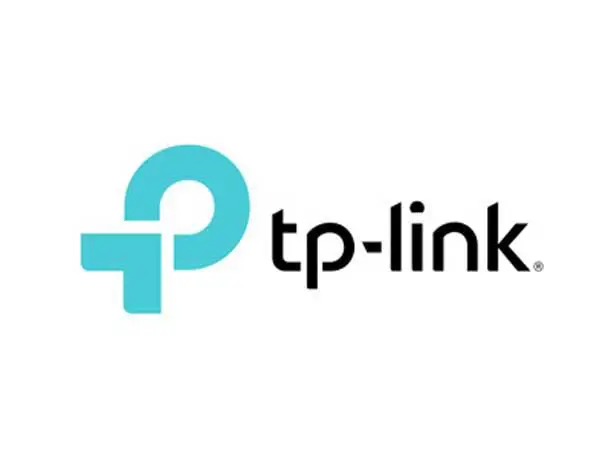
Niche Player: TP-Link
TP-Link, a Niche Player, comes to market with Omada, Omada Pro and associated network software products that are focused on addressing the needs of small and midsize enterprises. Most of the company’s revenue is generated from customers in EMEA.
Strengths: The company’s portfolio offers scalable network management bundled with its access network hardware, which provides unified monitoring. TP-Link also has a full Wi-Fi 6 portfolio and recently introduced Wi-Fi 7. The company offers very competitive pricing, Gartner said.
Weaknesses: TP-Link’s enterprise network portfolio falls behind when up against the competition and has limited AI/ML capabilities, according to Gartner. In addition, TP-Link’s portfolio lacks support for next-generation networking features such as network fabrics and dynamic segmentation, Gartner said.

Visionary: Arista Networks
One of two Visionaries, Arista Networks is catering to the enterprise networking market with its 700 series leaf switches and 7000 series enterprise spine switches; Cognitive Wi-Fi access points that include Wi-Fi 6E; and its CloudVision management platform. Gartner expects Arista to continue to invest in its CloudVision integrated security and AI and ML capabilities.
Strengths: Arista offers network management tools that simplify operations in the form of its CloudVision platform for unified campus and data center management. The company also has a differentiated network security strategy thanks to its NDR offering for advanced threat detection and incident response use cases.
Weaknesses: Arista has limited exposure outside its core data center customer base., according to Gartner. The company also has limited exposure outside North America, according to Gartner.
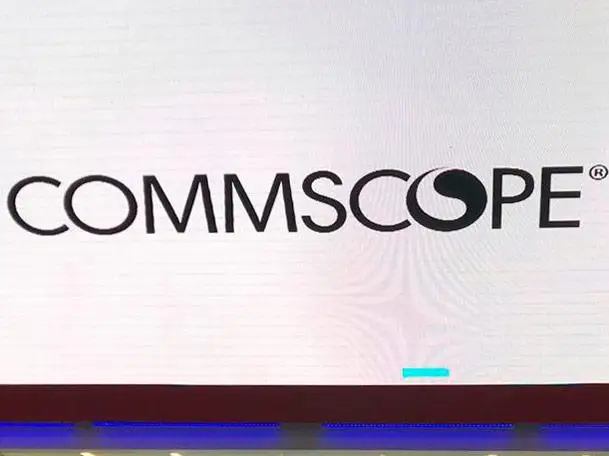
Visionary: CommScope Ruckus
CommScope-owned Ruckus Networks, a Visionary, comes to market with its Ruckus brand of ICX wired switches, R series wireless access points, and Ruckus One, its network management and AIOps platform. Gartner expects that Ruckus will continue to invest in the AIOps capabilities embedded into its Ruckus One platform and its network security and segmentation capabilities.
Strengths: The company offers strong network management with AIOps features, as well as detailed root cause analysis tools. Ruckus One also comes with integrated NAC functionality at no extra cost, Gartner said.
Weaknesses: Gartner said Ruckus has limited experience with large, complex network requirements and that the company has digital twin functionality gaps.